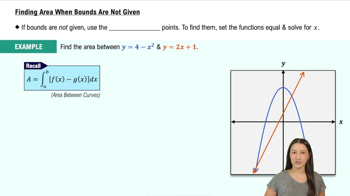Matching functions with area functions Match the functions ƒ, whose graphs are given in a― d, with the area functions A (𝓍) = ∫₀ˣ ƒ(t) dt, whose graphs are given in A–D.
Table of contents
- 0. Functions7h 54m
- Introduction to Functions16m
- Piecewise Functions10m
- Properties of Functions9m
- Common Functions1h 8m
- Transformations5m
- Combining Functions27m
- Exponent rules32m
- Exponential Functions28m
- Logarithmic Functions24m
- Properties of Logarithms36m
- Exponential & Logarithmic Equations35m
- Introduction to Trigonometric Functions38m
- Graphs of Trigonometric Functions44m
- Trigonometric Identities47m
- Inverse Trigonometric Functions48m
- 1. Limits and Continuity2h 2m
- 2. Intro to Derivatives1h 33m
- 3. Techniques of Differentiation3h 18m
- 4. Applications of Derivatives2h 38m
- 5. Graphical Applications of Derivatives6h 2m
- 6. Derivatives of Inverse, Exponential, & Logarithmic Functions2h 37m
- 7. Antiderivatives & Indefinite Integrals1h 26m
- 8. Definite Integrals4h 44m
- 9. Graphical Applications of Integrals2h 27m
- 10. Physics Applications of Integrals 3h 16m
- 11. Integrals of Inverse, Exponential, & Logarithmic Functions2h 34m
- 12. Techniques of Integration7h 41m
- 13. Intro to Differential Equations2h 55m
- 14. Sequences & Series5h 36m
- 15. Power Series2h 19m
- 16. Parametric Equations & Polar Coordinates7h 58m
8. Definite Integrals
Fundamental Theorem of Calculus
Problem 5.3.94a
Textbook Question
Working with area functions Consider the function ƒ and the points a, b, and c.
(a) Find the area function A (𝓍) = ∫ₐˣ ƒ(t) dt using the Fundamental Theorem.
ƒ(𝓍) = sin 𝓍 ; a = 0 , b = π/2 , c = π
 Verified step by step guidance
Verified step by step guidance1
Step 1: Understand the problem. You are tasked with finding the area function A(𝓍) = ∫ₐˣ ƒ(t) dt using the Fundamental Theorem of Calculus. The given function is ƒ(𝓍) = sin(𝓍), and the lower limit of integration is a = 0.
Step 2: Recall the Fundamental Theorem of Calculus. It states that if ƒ(t) is continuous on [a, x], then the derivative of the area function A(𝓍) with respect to 𝓍 is equal to ƒ(𝓍). In other words, A'(𝓍) = ƒ(𝓍).
Step 3: To find A(𝓍), integrate ƒ(t) = sin(t) with respect to t from the lower limit a = 0 to the upper limit x. The integral of sin(t) is -cos(t). Therefore, A(𝓍) = -cos(t) evaluated from t = 0 to t = x.
Step 4: Apply the limits of integration. Substitute the upper limit x and the lower limit 0 into the expression for A(𝓍). This gives A(𝓍) = [-cos(x)] - [-cos(0)]. Simplify the expression using the fact that cos(0) = 1.
Step 5: The area function A(𝓍) is now expressed in terms of x. You can use this function to evaluate the area for specific values of x, such as b = π/2 and c = π, by substituting these values into A(𝓍).
 Verified video answer for a similar problem:
Verified video answer for a similar problem:This video solution was recommended by our tutors as helpful for the problem above
Video duration:
2mPlay a video:
Was this helpful?
Key Concepts
Here are the essential concepts you must grasp in order to answer the question correctly.
Fundamental Theorem of Calculus
The Fundamental Theorem of Calculus links the concept of differentiation with integration. It states that if a function is continuous on an interval, then the integral of its derivative over that interval can be computed using the values of the function at the endpoints. This theorem allows us to evaluate definite integrals and find area functions effectively.
Recommended video:

Fundamental Theorem of Calculus Part 1
Definite Integral
A definite integral represents the signed area under a curve defined by a function over a specific interval [a, b]. It is calculated as the limit of Riemann sums and provides a numerical value that corresponds to the total accumulation of the function's values between the two bounds. In this context, it is used to find the area function A(x) from the function f(t).
Recommended video:

Definition of the Definite Integral
Area Function
An area function A(x) is defined as the integral of a function f(t) from a constant lower limit a to a variable upper limit x. It represents the accumulated area under the curve of f(t) from a to x. In this problem, A(x) = ∫ₐˣ f(t) dt will help us determine the area under the curve of sin(x) from 0 to x, which is essential for understanding the behavior of the function over the specified interval.
Recommended video:

Finding Area When Bounds Are Not Given

 6:11m
6:11mWatch next
Master Fundamental Theorem of Calculus Part 1 with a bite sized video explanation from Patrick
Start learningRelated Videos
Related Practice
Textbook Question
15
views
